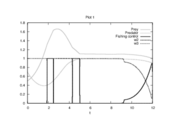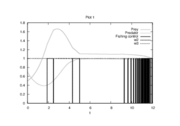Difference between revisions of "Egerstedt standard problem"
ClemensZeile (Talk | contribs) |
ClemensZeile (Talk | contribs) |
||
| Line 28: | Line 28: | ||
\end{array} | \end{array} | ||
</math> | </math> | ||
| − | |||
</p> | </p> | ||
| + | for <math>t \in [t_0, t_f]=[0,1] </math>. | ||
== Reference Solutions == | == Reference Solutions == | ||
| − | If the problem is relaxed, i.e., we demand that <math>w(t)</math> be in the continuous interval <math>[0, 1]</math> instead of the binary choice <math>\{0,1\}</math>, the optimal solution can be determined by | + | If the problem is relaxed, i.e., we demand that <math>w(t)</math> be in the continuous interval <math>[0, 1]</math> instead of the binary choice <math>\{0,1\}</math>, the optimal solution can be determined by using a direct method such as collocation or Bock's direct multiple shooting method. |
| − | The optimal objective value of | + | The optimal objective value of the relaxed problem with <math> n_t=6000, \, n_u=40 </math> is <math>x_3(t_f)=1.0.995906234</math>. The objective value of the binary controls obtained by Combinatorial Integral Approimation (CIA) is <math>x_3(t_f) =3.20831942</math>. The binary control solution was evaluated in the MIOCP by using a Merit function with additional Lagrange term <math> 100 \max\limits_{t\in[0,1]}\{0,0.4-x_2(t)\} </math>. |
<gallery caption="Reference solution plots" widths="180px" heights="140px" perrow="2"> | <gallery caption="Reference solution plots" widths="180px" heights="140px" perrow="2"> | ||
| − | Image: | + | Image:MmlotkaRelaxed_12000_30_1.png| Optimal relaxed controls and states determined by an direct approach with ampl_mintoc (Radau collocation) and <math>n_t=12000, \, n_u=400</math>. |
| − | + | Image:MmlotkaCIA 12000 30 1.png| Optimal binary controls and states determined by an direct approach (Radau collocation) with ampl_mintoc and <math>n_t=12000, \, n_u=400</math>. The relaxed controls were approximated by Combinatorial Integral Approximation. | |
| − | Image: | + | |
| − | + | ||
</gallery> | </gallery> | ||
| + | |||
Revision as of 15:11, 10 January 2018
| Egerstedt standard problem | |
|---|---|
| State dimension: | 1 |
| Differential states: | 3 |
| Discrete control functions: | 3 |
| Path constraints: | 1 |
| Interior point equalities: | 3 |
The Egerstedt standard problemm is the problem is of an academic nature and was proposed by Egerestedt to highlight the features of an Hybrid System algorithm in 2006 [Egerstedt2006]Author: M. Egerstedt; Y. Wardi; H. Axelsson
Journal: IEEE Transactions on Automatic Control
Pages: 110--115
Title: Transition-time optimization for switched-mode dynamical systems
Volume: 51
Year: 2006 . It has been used since then in many MIOCP research studies (e.g. [Jung2013]Author: M. Jung; C. Kirches; S. Sager
. It has been used since then in many MIOCP research studies (e.g. [Jung2013]Author: M. Jung; C. Kirches; S. Sager
Booktitle: Facets of Combinatorial Optimization -- Festschrift for Martin Gr\"otschel
Editor: M. J\"unger and G. Reinelt
Pages: 387--417
Publisher: Springer Berlin Heidelberg
Title: On Perspective Functions and Vanishing Constraints in Mixed-Integer Nonlinear Optimal Control
Url: http://www.mathopt.de/PUBLICATIONS/Jung2013.pdf
Year: 2013 ) for benchmarking of MIOCP algorithms.
) for benchmarking of MIOCP algorithms.
Contents
[hide]Mathematical formulation
The mixed-integer optimal control problem after partial outer convexification is given by
![\begin{array}{llclr}
\displaystyle \min_{x, \omega} & x_3(t_f) \\[1.5ex]
\mbox{s.t.}
& \dot{x}_1 & = & -x_1\omega_1 + (x_1+x_2)\omega_2+(x_1-x_2)\omega_3, \\
& \dot{x}_2 & = & (x_1+2x_2)\omega_1+(x_1-2x_2)\omega_2+(x_1+x_2)\omega_3, \\
& \dot{x}_3 & = & x_1^2+x_2^2, \\[1.5ex]
& x(0) &=& (0.5, 0.5, 0)^T, \\
& x_2(t) & \geq & 0.4, \\
& 1 &=& \sum\limits_{i=1}^3\omega_i(t), \\
& \omega(t) &\in& \{0, 1\},
\end{array}](https://mintoc.de/images/math/2/0/8/208ecb2b5782a3106028f82d6458c1ba.png)
for ![t \in [t_0, t_f]=[0,1]](https://mintoc.de/images/math/3/4/e/34e97321e38e35c980a25b5da6ebb7b8.png) .
.
Reference Solutions
If the problem is relaxed, i.e., we demand that  be in the continuous interval
be in the continuous interval ![[0, 1]](https://mintoc.de/images/math/c/c/f/ccfcd347d0bf65dc77afe01a3306a96b.png) instead of the binary choice
instead of the binary choice  , the optimal solution can be determined by using a direct method such as collocation or Bock's direct multiple shooting method.
, the optimal solution can be determined by using a direct method such as collocation or Bock's direct multiple shooting method.
The optimal objective value of the relaxed problem with  is
is  . The objective value of the binary controls obtained by Combinatorial Integral Approimation (CIA) is
. The objective value of the binary controls obtained by Combinatorial Integral Approimation (CIA) is  . The binary control solution was evaluated in the MIOCP by using a Merit function with additional Lagrange term
. The binary control solution was evaluated in the MIOCP by using a Merit function with additional Lagrange term ![100 \max\limits_{t\in[0,1]}\{0,0.4-x_2(t)\}](https://mintoc.de/images/math/0/f/a/0fabc73d7f238f7afc86bde9b0bbf37f.png) .
.
- Reference solution plots
Source Code
Model descriptions are available in
- ACADO code at Lotka Volterra fishing problem (ACADO)
- AMPL code at Lotka Volterra fishing problem (AMPL)
- APMonitor code at Lotka Volterra fishing problem (APMonitor)
- Bocop code at Lotka Volterra fishing problem (Bocop)
- Casadi code at Lotka Volterra fishing problem (Casadi)
- JModelica code at Lotka Volterra fishing problem (JModelica)
- JuMP code at Lotka Volterra fishing problem (JuMP)
- Muscod code at Lotka Volterra fishing problem (Muscod)
- switch code at Lotka Volterra fishing problem (switch)
- PROPT code at Lotka Volterra fishing problem (TomDyn/PROPT)
Variants
There are several alternative formulations and variants of the above problem, in particular
- a prescribed time grid for the control function [Sager2006]Address: Heidelberg
Author: S. Sager; H.G. Bock; M. Diehl; G. Reinelt; J.P. Schl\"oder
Booktitle: Recent Advances in Optimization
Editor: A. Seeger
Note: ISBN 978-3-5402-8257-0
Pages: 269--289
Publisher: Springer
Series: Lectures Notes in Economics and Mathematical Systems
Title: Numerical methods for optimal control with binary control functions applied to a Lotka-Volterra type fishing problem
Volume: 563
Year: 2009 , see also Lotka Volterra fishing problem (AMPL),
, see also Lotka Volterra fishing problem (AMPL), - a time-optimal formulation to get into a steady-state [Sager2005]Address: Tönning, Lübeck, Marburg
Author: S. Sager
Editor: ISBN 3-89959-416-9
Publisher: Der andere Verlag
Title: Numerical methods for mixed--integer optimal control problems
Url: http://mathopt.de/PUBLICATIONS/Sager2005.pdf
Year: 2005 ,
, - the usage of a different target steady-state, as the one corresponding to
 which is
which is  , see Lotka Volterra multi-arcs problem
, see Lotka Volterra multi-arcs problem - different fishing control functions for the two species, see Lotka Volterra Multimode fishing problem
- different parameters and start values.
Miscellaneous and Further Reading
The Lotka Volterra fishing problem was introduced by Sebastian Sager in a proceedings paper [Sager2006]Address: Heidelberg
Author: S. Sager; H.G. Bock; M. Diehl; G. Reinelt; J.P. Schl\"oder
Booktitle: Recent Advances in Optimization
Editor: A. Seeger
Note: ISBN 978-3-5402-8257-0
Pages: 269--289
Publisher: Springer
Series: Lectures Notes in Economics and Mathematical Systems
Title: Numerical methods for optimal control with binary control functions applied to a Lotka-Volterra type fishing problem
Volume: 563
Year: 2009 and revisited in his PhD thesis [Sager2005]Address: Tönning, Lübeck, Marburg
and revisited in his PhD thesis [Sager2005]Address: Tönning, Lübeck, Marburg
Author: S. Sager
Editor: ISBN 3-89959-416-9
Publisher: Der andere Verlag
Title: Numerical methods for mixed--integer optimal control problems
Url: http://mathopt.de/PUBLICATIONS/Sager2005.pdf
Year: 2005 . These are also the references to look for more details.
. These are also the references to look for more details.
References
| [Egerstedt2006] | M. Egerstedt; Y. Wardi; H. Axelsson (2006): Transition-time optimization for switched-mode dynamical systems. IEEE Transactions on Automatic Control, 51, 110--115 |  |
| [Jung2013] | M. Jung; C. Kirches; S. Sager (2013): On Perspective Functions and Vanishing Constraints in Mixed-Integer Nonlinear Optimal Control. Facets of Combinatorial Optimization -- Festschrift for Martin Gr\"otschel |  |
| [Sager2005] | S. Sager (2005): Numerical methods for mixed--integer optimal control problems. (%edition%). Der andere Verlag, Tönning, Lübeck, Marburg, %pages% |  |
| [Sager2006] | S. Sager; H.G. Bock; M. Diehl; G. Reinelt; J.P. Schl\"oder (2009): Numerical methods for optimal control with binary control functions applied to a Lotka-Volterra type fishing problem. Springer, Recent Advances in Optimization |  |
| [Sager2011d] | S. Sager: On the Integration of Optimization Approaches for Mixed-Integer Nonlinear Optimal Control, 2011 |  |
We present numerical results for a benchmark MIOCP from a previous study [157] with the
addition of switching constraints. In its original form, the problem was:
After partial outer convexification with respect to the integer control v, the binary
convexified counterpart problem reads

 .
.
